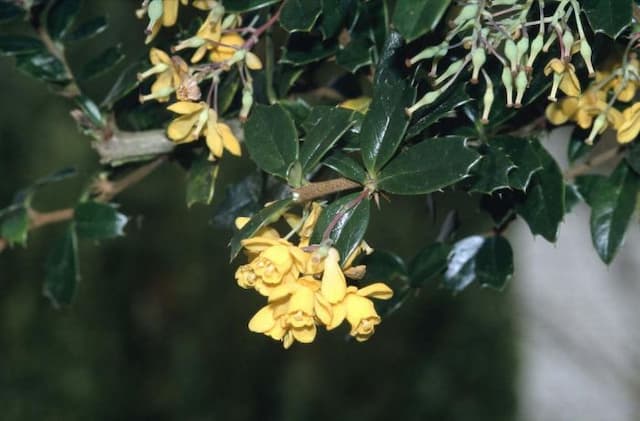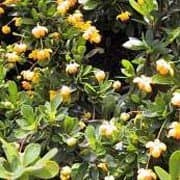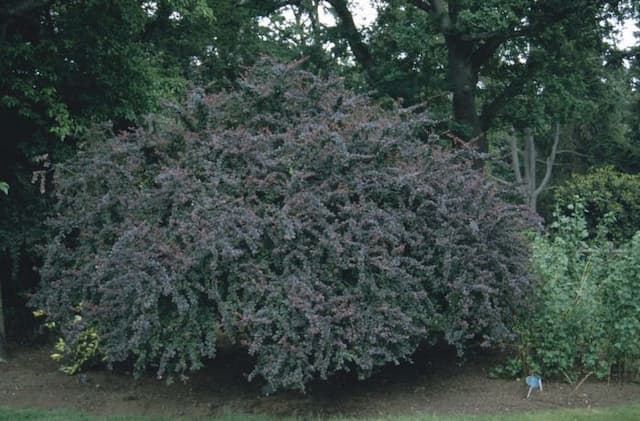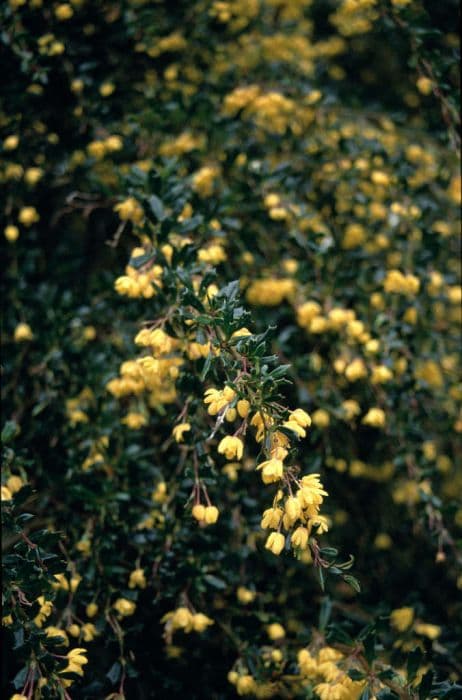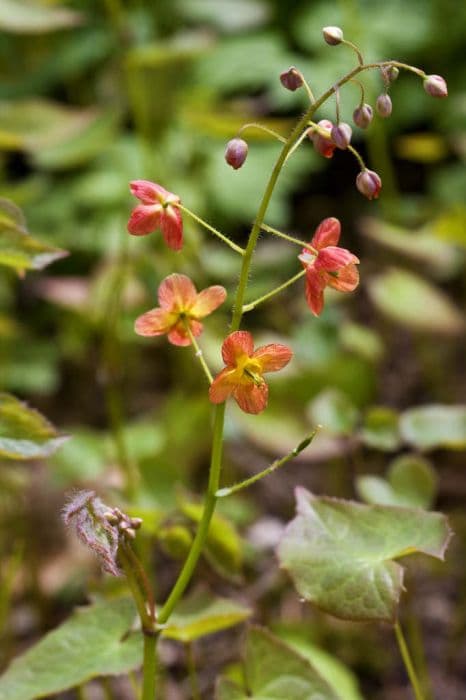Japanese Barberry Berberis thunbergii f. atropurpurea 'Harlequin' (v)

ABOUT
The 'Harlequin' is a variant of the Japanese barberry that is admired for its particularly striking foliage and ornamental value in gardens and landscapes. This plant showcases leaves that have a unique coloration pattern—typically a deep purple with splashes of white to pink variegation, giving it a mottled and speckled look. The leaves are small, oval-shaped, and when they emerge in the spring they have a fresh, brighter appearance, which darkens to the richer tones as the season progresses. The branches of this shrub are arching, forming an attractive, dense mound that is composed of numerous small twigs and stems. Thorns are present, which are sharp and straight, lending to its common application as a barrier or hedge in landscaping. In spring, the plant produces tiny, inconspicuous yellow flowers that add to its beauty and provide a contrast to the dark foliage. Later in the season, these may develop into small, bright red berries that are attractive to birds but considered inedible for humans. The berries can provide visual interest well into the fall and even winter, complementing the foliage which can take on additional reddish tones before falling off as the cold sets in. Overall, the 'Harlequin' Japanese barberry is treasured for its color contrast and texture that it brings to gardens, with its leaves being the most striking aspect of its appearance. With the combination of the colored foliage, yellow flowers, and red berries, it provides a multi-season display of color and interest.
About this plant
 Names
NamesSynonyms
Japanese Barberry, Red-Barberry, Harlequin Barberry.
Common names
Berberis thunbergii var. atropurpurea 'Harlequin'.
 Toxicity
ToxicityTo humans
The Japanese barberry is not generally considered highly toxic to humans. However, if ingested, parts of the plant, especially the berries, can potentially cause gastrointestinal disturbances, such as nausea, vomiting, diarrhea, and abdominal cramps. It's important to exercise caution and prevent children from ingesting any part of the plant.
To pets
The Japanese barberry is also not known to be highly toxic to pets, but similarly to humans, consumption of parts of this plant, particularly the berries, may result in gastrointestinal upset in animals as well. Symptoms of poisoning in pets can include vomiting, diarrhea, and signs of abdominal pain. Pet owners should keep an eye on their animals and prevent them from eating any part of the plant to avoid such issues.
 Characteristics
CharacteristicsLife cycle
Perennials
Foliage type
Deciduous
Color of leaves
Variegated
Flower color
Yellow
Height
2-3 feet (0.6-0.9 meters)
Spread
2-4 feet (0.6-1.2 meters)
Plant type
Shrub
Hardiness zones
4-8
Native area
Japan
Benefits
 General Benefits
General Benefits- Ornamental Appeal: 'Harlequin' is highly valued for its decorative foliage that adds visual interest to landscapes and gardens with its variegated pink, white, and purple leaves.
- Seasonal Color: It offers year-round interest with vivid fall colors and red berries that persist into winter.
- Drought Tolerance: Once established, it is quite drought-resistant, requiring minimal watering, which makes it suitable for xeriscaping.
- Low Maintenance: 'Harlequin' requires minimal care once established, making it an excellent choice for gardeners seeking low-maintenance landscaping options.
- Erosion Control: Its root system helps to stabilize soil and control erosion, especially on slopes and banks.
- Hedge and Barrier: It can be pruned into a hedge or left unpruned to grow into a natural barrier due to its thorny branches.
- Wildlife Support: The berries provide food for birds during the winter months when other sources are scarce.
 Medical Properties
Medical PropertiesThis plant is not used for medical purposes.
 Air-purifying Qualities
Air-purifying QualitiesThis plant is not specifically known for air purifying qualities.
 Other Uses
Other Uses- Photography Prop: The 'Harlequin' Japanese Barberry, with its striking variegated foliage, can be used as an intriguing backdrop or subject in garden photography.
- Dried Arrangements: Branches of the plant can be cut and dried, retaining their interesting color to be used in long-lasting floral displays.
- Natural Barriers: The thorny nature of the 'Harlequin' Japanese Barberry makes it an excellent choice for creating defensive hedges to discourage trespassing animals or humans.
- Erosion Control: It can be planted on slopes or areas prone to erosion to help stabilize the soil with its extensive root system.
- Theme Gardens: This plant is perfect for gothic or 'black' themed gardens due to its dark purple foliage that complements other dark-colored plants.
- Winter Interest: Even after the leaves drop, the bright red berries and textured bark provide visual interest in the garden during the dormant season.
- Bonsai: With its small leaves and thorny branches, the 'Harlequin' Japanese Barberry can be trained into an attractive bonsai specimen.
- Lure for Wildlife Photography: Birds are attracted to its berries, so planting it can enhance opportunities for bird watching and photography.
- Culinary Decoration: Although not for consumption, the berries can be used as non-edible garnishes for adding color to food platters or drinks at events.
- Contrast Planting: It can be specifically planted to contrast with green-leaved plants, brightening up the garden design with its deep red-purple foliage.
Interesting Facts
 Feng Shui
Feng ShuiThe Japanese Barberry is not used in Feng Shui practice.
 Zodiac Sign Compitability
Zodiac Sign CompitabilityThe Japanese Barberry is not used in astrology practice.
 Plant Symbolism
Plant Symbolism- Protection: The Japanese Barberry is often associated with protection due to its thorny branches which can form a barrier.
- Intrigue: Its unique purplish-red foliage, especially of the 'Harlequin' variety, is seen as a symbol of intrigue and fascination.
 Water
WaterThe Japanese Barberry 'Harlequin' prefers a consistent watering schedule, generally requiring water when the top inch of soil feels dry to the touch. This deciduous shrub should be watered deeply to encourage root development, with approximately 1 to 1.5 gallons per week during the growing season. Watering frequency should be reduced in the fall and winter, providing enough to keep the soil moist but not waterlogged. During periods of drought or extreme heat, additional water may be necessary. It's best to water early in the morning to reduce evaporation and minimize the risk of fungal diseases.
 Light
LightThe Japanese Barberry 'Harlequin' thrives best in full sun to part shade. Ideally, it should receive at least 6 hours of direct sunlight daily for vibrant foliage color. Locations that provide morning sunlight with some afternoon shade are suitable. Too much shade can lead to less intense foliage color and reduced flowering.
 Temperature
TemperatureThe Japanese Barberry 'Harlequin' is hardy in a wide range of temperatures and can withstand winter temperatures down to -30 degrees Fahrenheit. The ideal growing temperature for this shrub is between 60 and 70 degrees Fahrenheit during the growing season. It can handle summer heat up to about 90 degrees Fahrenheit without stress.
 Pruning
PruningPruning the Japanese Barberry 'Harlequin' helps maintain its shape, remove dead or diseased wood, and encourage healthy growth. Prune in late winter or early spring before new growth starts. Thinning out older branches every few years allows light into the center of the shrub, which promotes a more vigorous plant. Annual pruning to shape the shrub can also be done after it flowers.
 Cleaning
CleaningNot needed
 Soil
SoilJapanese Barberry 'Harlequin' thrives in well-draining, loamy soil with a pH range of 5.5 to 7.5. A mix with equal parts garden soil, compost, and perlite or sand is ideal to ensure proper drainage and fertility.
 Repotting
RepottingJapanese Barberry 'Harlequin' does not require frequent repotting; it can be repotted every 2-3 years or when it outgrows its current container.
 Humidity & Misting
Humidity & MistingJapanese Barberry 'Harlequin' is tolerant of a wide range of humidity levels and does well in average outdoor humidity without the need for additional humidity control.
 Suitable locations
Suitable locationsIndoor
Place in bright light, avoid overwatering, minimal care needed.
Outdoor
Full sun to partial shade; well-draining soil; water regularly.
Hardiness zone
4-8 USDA
 Life cycle
Life cycleJapanese barberry 'Harlequin' begins its life as a seed, which, upon germination given the right conditions of warmth and moisture, sends forth a small root (radicle) and a shoot that will develop into the plant's stem. During the vegetative stage, the plant grows leaves with a characteristic purple mottled foliage and thorny stems, establishing itself as a hardy deciduous shrub. As it reaches maturity, the plant produces clusters of small, yellow flowers in the spring, which are pollinated by insects, leading to the development of bright red, oblong berries that attract birds and other wildlife, aiding in seed dispersal. After seed dispersal in late summer to early fall, the plant enters a period of dormancy during the winter months, wherein the leaves fall and growth slows down considerably. The cycle recommences in the spring when new growth emerges from the woody stems, and the plant resumes its vegetative and reproductive activities. Throughout its life, Japanese barberry 'Harlequin' can also spread vegetatively through root suckers, allowing it to form dense thickets over time.
 Propogation
PropogationPropogation time
Summer
The best time to propagate the Japanese barberry 'Harlequin' is in the late fall or winter when the plant is dormant, although it can also be done in early spring before growth begins. One of the most popular methods of propagation for this variety is softwood cuttings. This involves taking a cutting of new growth, typically 4 to 6 inches (10 to 15 centimeters) long, that is not yet hard or mature. The bottom leaves are stripped off and the cut end is often dipped in a rooting hormone powder to enhance root development. The prepared cutting is then inserted into a well-draining potting mix, and the environment is kept humid to encourage rooting. Within a few weeks to a couple of months, roots should develop, after which the new plant can be transplanted into a larger pot or directly into the garden.
